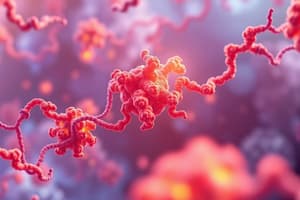Podcast
Questions and Answers
What is the primary function of enzyme-linked receptors?
What is the primary function of enzyme-linked receptors?
- To regulate gene expression
- To provide structure to the cell membrane
- To receive signals from the environment (correct)
- To synthesize proteins
What is the term for the part of the enzyme-linked receptor that binds a ligand?
What is the term for the part of the enzyme-linked receptor that binds a ligand?
- Ligand-binding domain (correct)
- Transmembrane domain
- Enzymatic domain
- Catalytic domain
What is the name of the most widely recognized type of enzyme-linked receptor?
What is the name of the most widely recognized type of enzyme-linked receptor?
- Receptor tyrosine kinases (correct)
- Ligand-gated ion channels
- G-protein coupled receptors
- Receptor serine/threonine kinases
What is the role of enzymes in the body?
What is the role of enzymes in the body?
What is the environment outside the cell called?
What is the environment outside the cell called?
What is the name of the domain that acts as an enzyme in enzyme-linked receptors?
What is the name of the domain that acts as an enzyme in enzyme-linked receptors?
What type of molecules can bind to receptor tyrosine kinases?
What type of molecules can bind to receptor tyrosine kinases?
What is the term for enzyme-linked receptors that also function as enzymes?
What is the term for enzyme-linked receptors that also function as enzymes?
What is the primary function of Receptor Tyrosine Kinases (RTKs) in our body?
What is the primary function of Receptor Tyrosine Kinases (RTKs) in our body?
What happens when RTKs fail to function properly?
What happens when RTKs fail to function properly?
What is the name of the breast cancer drug that targets a particular RTK?
What is the name of the breast cancer drug that targets a particular RTK?
What is the result of the binding of a signaling molecule with an RTK?
What is the result of the binding of a signaling molecule with an RTK?
What is the ultimate effect of RTK signal transduction?
What is the ultimate effect of RTK signal transduction?
What type of receptors do RTKs belong to?
What type of receptors do RTKs belong to?
What is the role of RTKs in developmental processes?
What is the role of RTKs in developmental processes?
What type of growth factors use RTKs?
What type of growth factors use RTKs?
What is unique about receptor tyrosine kinases?
What is unique about receptor tyrosine kinases?
What is the general term for something that has the ability to transfer phosphorus molecules?
What is the general term for something that has the ability to transfer phosphorus molecules?
What happens when a signaling molecule binds to an RTK?
What happens when a signaling molecule binds to an RTK?
What is the process called when one RTK phosphorylates the tyrosine on the other RTK?
What is the process called when one RTK phosphorylates the tyrosine on the other RTK?
What is required for proteins to dock with the phosphorylated tyrosines?
What is required for proteins to dock with the phosphorylated tyrosines?
Why do RTKs need to act in pairs?
Why do RTKs need to act in pairs?
What is the result of cross-phosphorylation of RTKs?
What is the result of cross-phosphorylation of RTKs?
What can bind to the phosphorylated tyrosines on the RTKs?
What can bind to the phosphorylated tyrosines on the RTKs?
What is the final result of the signaling process initiated by RTKs?
What is the final result of the signaling process initiated by RTKs?
What is the function of the enzymatic section of RTKs?
What is the function of the enzymatic section of RTKs?
Flashcards are hidden until you start studying
Study Notes
Enzyme-Linked Receptors
- Enzyme-linked receptors are transmembrane proteins that receive signals from the environment and instruct the cell to perform certain actions.
- They function as enzymes, binding to a signaling molecule, which activates the receptor's enzymatic activity.
- This type of receptor is also known as a catalytic receptor.
Structure of Enzyme-Linked Receptors
- The general structure of enzyme-linked receptors consists of an extracellular ligand-binding domain and an intracellular enzymatic domain.
- The extracellular domain binds to a ligand, which causes the intracellular domain to act as an enzyme.
Receptor Tyrosine Kinases (RTKs)
- RTKs are the most widely recognized and common type of enzyme-linked receptors.
- They regulate cell growth, differentiation, and survival, and can bind and respond to ligands such as growth factors.
- RTKs have tyrosine on the intracellular enzymatic section, which is unique to this type of receptor.
- The term "kinase" refers to the ability to transfer phosphorus molecules, usually from ATP, to intracellular proteins, which activates them.
Mechanism of RTKs
- RTKs occur in pairs and are activated when a signaling molecule binds to the ligand-binding site, causing the two receptors to come together and form a cross-linked dimer.
- Cross-linking activates the tyrosine kinase activity in the RTKs through phosphorylation, allowing them to transfer phosphorus molecules to intracellular proteins.
- This process is known as cross-phosphorylation, where one RTK phosphorylates the tyrosines on the other RTK.
- The phosphorylated tyrosines then serve as docking platforms for different intracellular proteins involved in signal transduction.
Signal Transduction
- Multiple different SH2-containing proteins can bind to the phosphorylated tyrosines, allowing activation of multiple intracellular signaling pathways at the same time.
- The signal transduction process can be complex and often ends at the nucleus, affecting gene transcription, which ultimately affects protein production.
Functions of RTKs
- RTKs primarily regulate cell growth and differentiation, and are involved in various developmental processes, including tissue architecture, placement of nerve endings, and blood vessel maturation.
- They can also bind hormones, such as insulin, and are involved in the regulation of surface proteins called ephrins.
Importance of RTKs
- RTKs play a crucial role in many cellular processes, and their dysfunction can lead to issues in cell growth and differentiation, contributing to the development of cancers.
- Because of this, RTKs are a target of many drugs used in chemotherapy, such as Herceptin, which binds and inhibits a particular RTK that is overexpressed in many breast cancers.
Studying That Suits You
Use AI to generate personalized quizzes and flashcards to suit your learning preferences.




